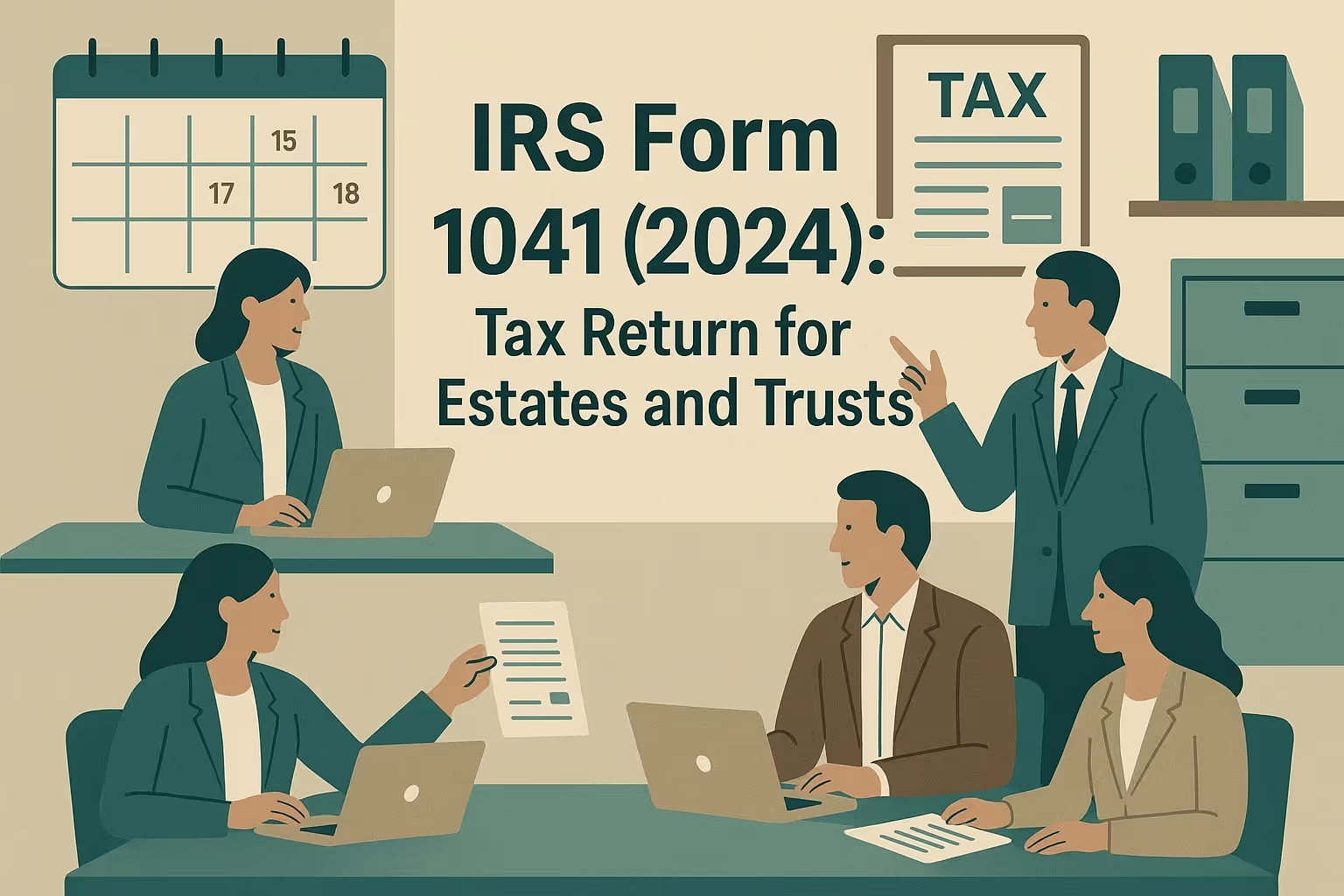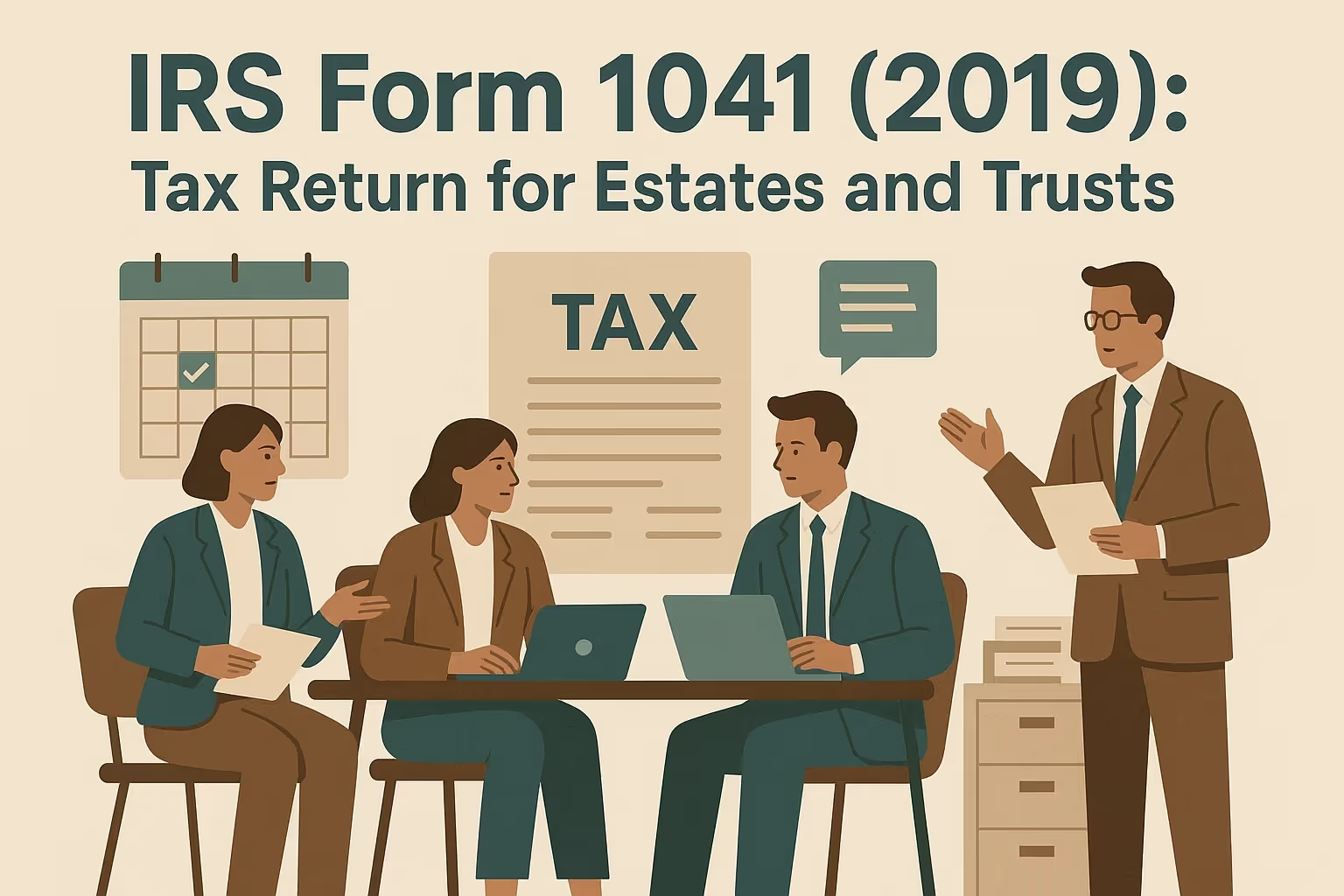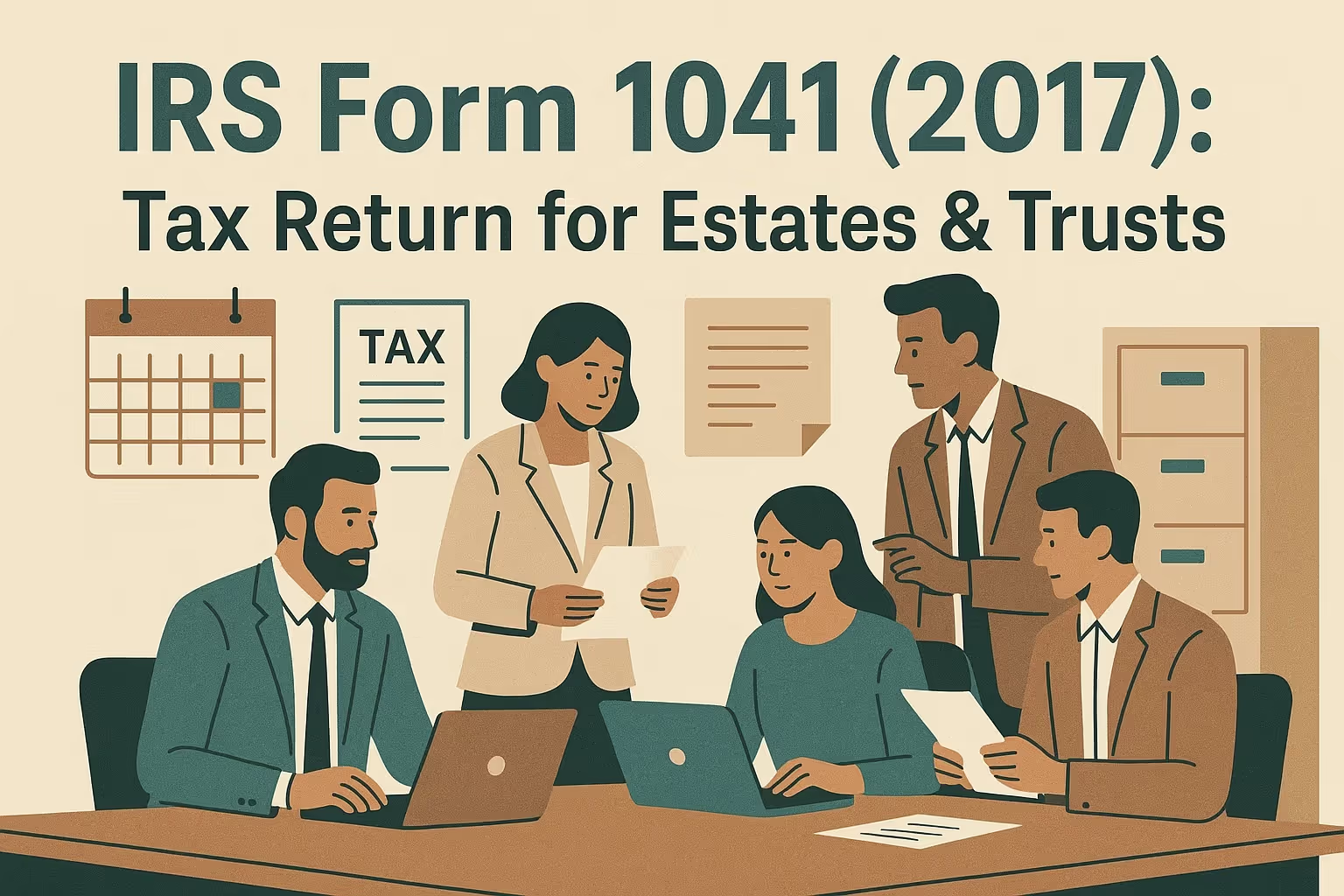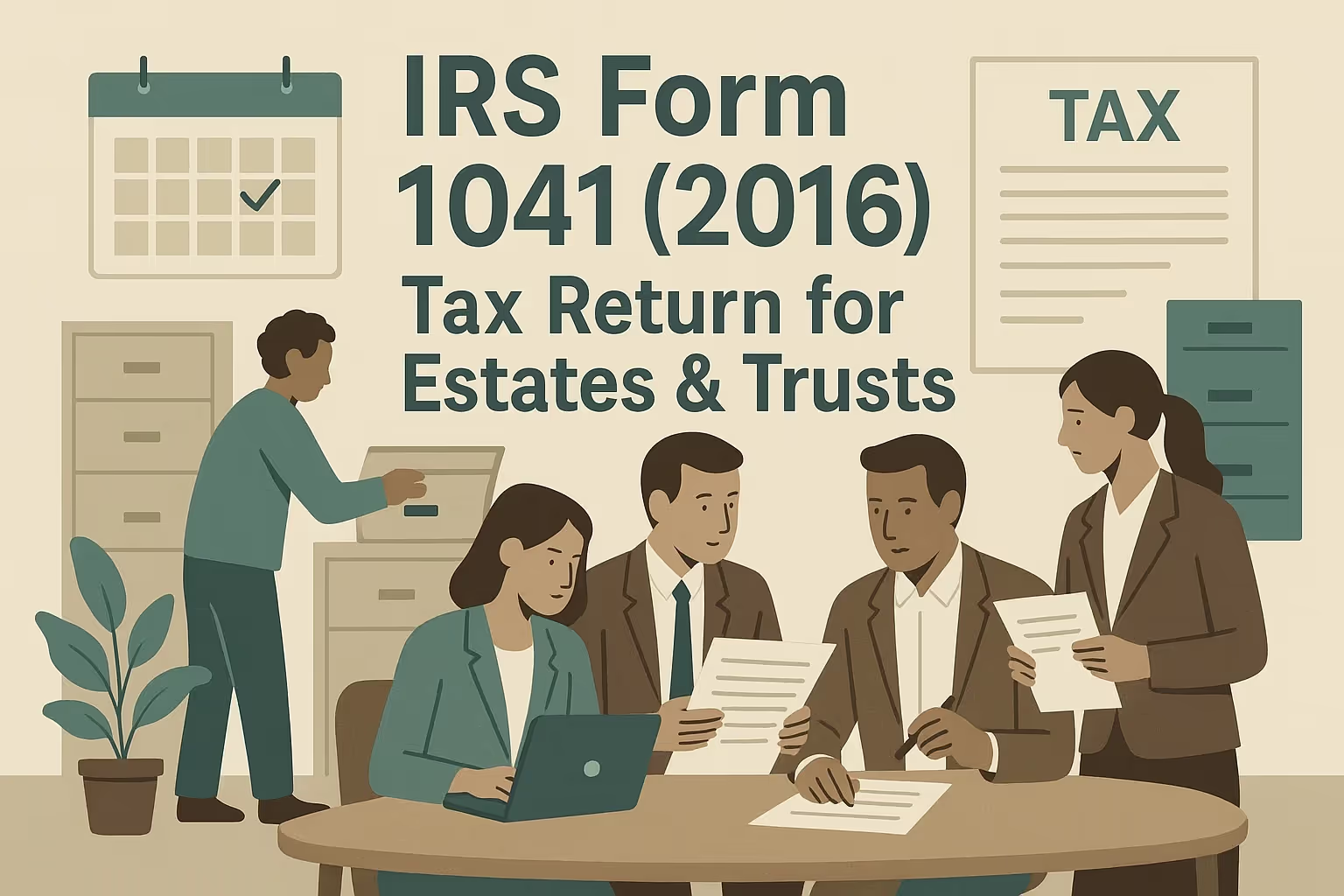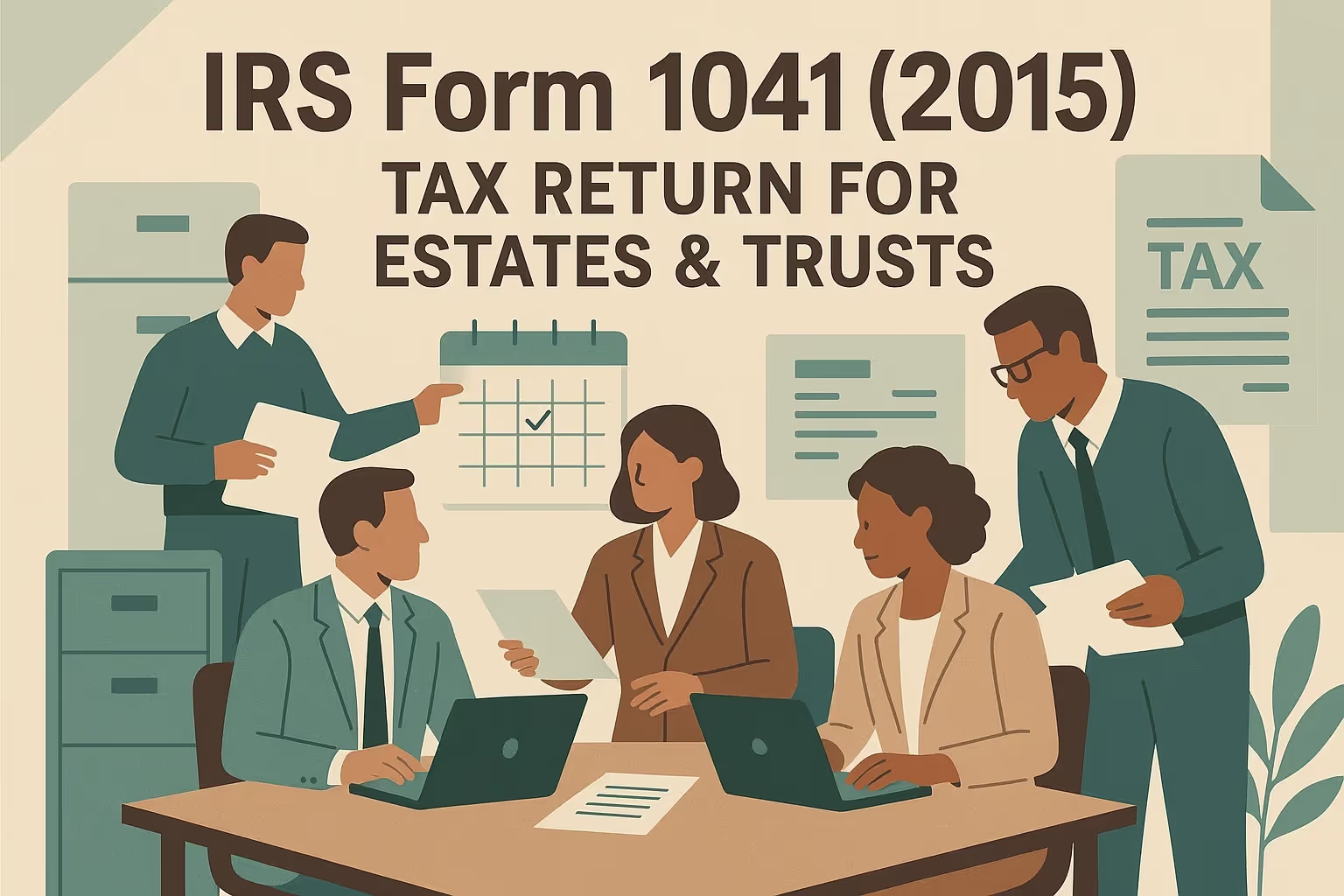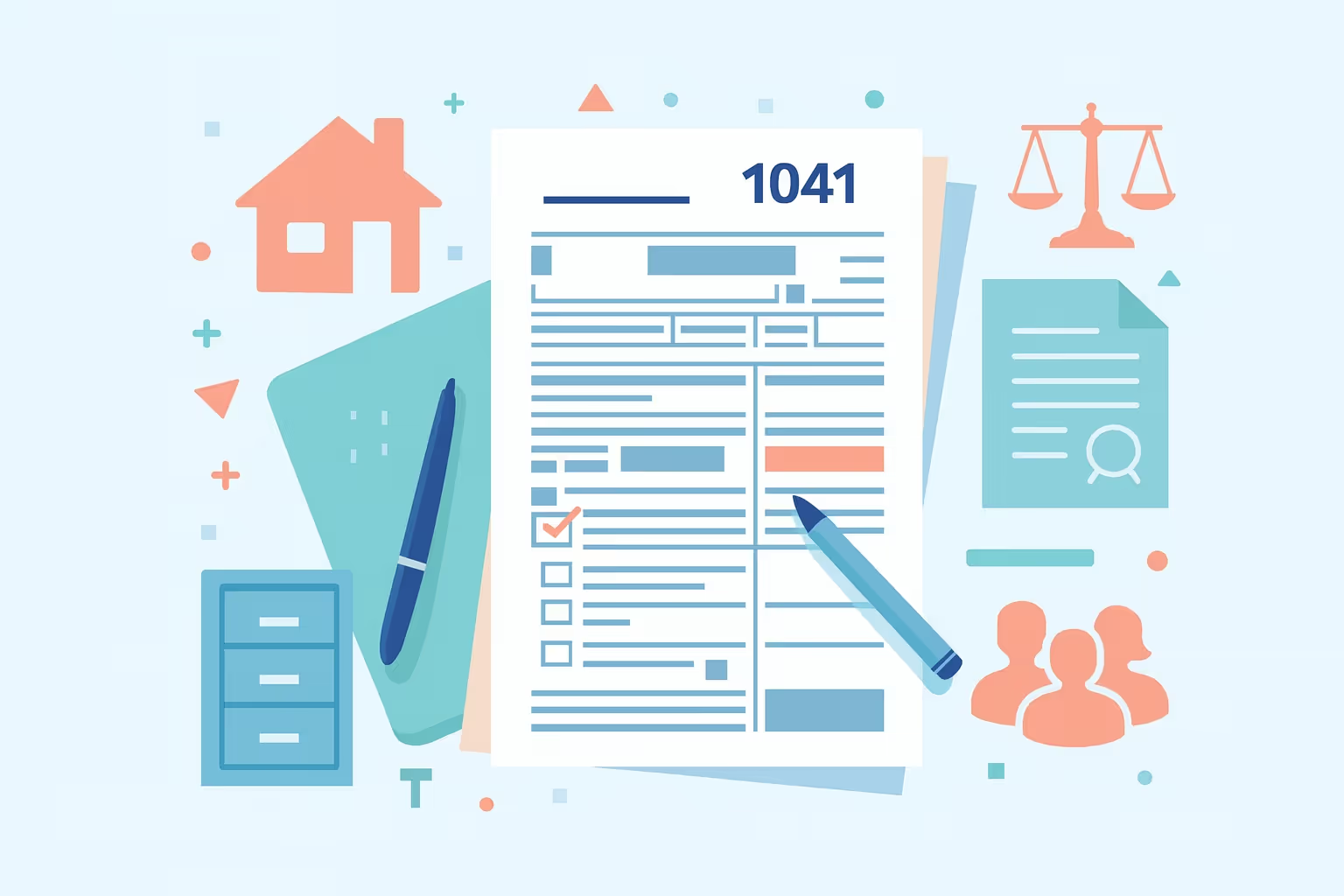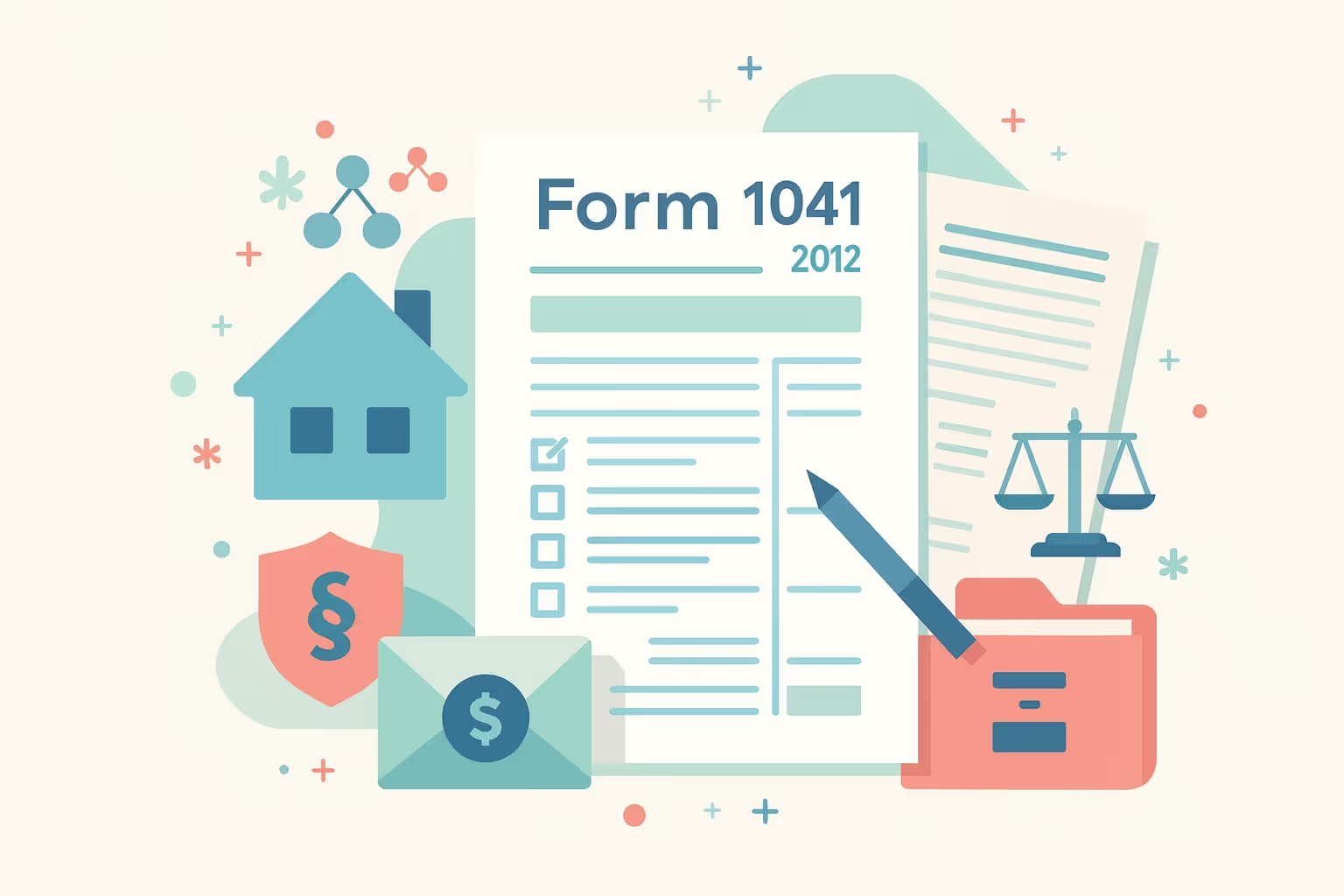How to File Federal Form 1041 for Tax Year 2024
In 2023, the Internal Revenue Service reported more than 3.5 million fiduciary income tax returns filed by estates and trusts. Thousands of these were delayed because of missing information or simple errors, which meant refund delays stretching into months and unexpected penalties that cost hundreds of dollars. For 2024, fiduciaries cannot afford these costly mistakes, especially with new filing thresholds and updated capital gains tax rates that make accuracy more important than ever.
Federal Form 1041 for 2024 is the official fiduciary income tax return for estates and trusts. This form reports income generated after a decedent’s death, including dividend income, interest, capital gains, and other income-producing assets. It is not the same as a personal income tax return: Form 1040 closes out the decedent’s lifetime earnings, while Form 1041 manages the income the estate generates during administration. For trusts, it determines how much of the total income stays taxable to the trust versus being passed through to beneficiaries.
Errors on this return can create lasting financial consequences. Misreporting distributable net income can trigger double taxation; missing the filing deadline results in a penalty of 5 percent of unpaid tax each month; and failing to provide Schedule K-1s to beneficiaries can cost $330 per form. On the other hand, filing Federal Form 1041 for tax year 2024 electronically can speed refunds to as little as 30 days, compared with more than eight weeks for a paper filing. Fiduciaries who start early, keep accurate records, and claim all available deductions protect beneficiaries and prevent the estate or trust from paying more than necessary.
Understanding Federal Form 1041 for Tax Year 2024
Filing a fiduciary income tax return starts with understanding exactly what Federal Form 1041 for tax year 2024 is meant to do. The Internal Revenue Service uses this form to ensure that income generated by an estate or trust is taxed adequately before any distributions are made to beneficiaries. This is a critical part of estate administration: it keeps the estate compliant with federal tax law. It ensures that beneficiaries receive accurate income reporting for their personal income tax returns.
What Is Form 1041
Form 1041, U.S. Income Tax Return for Estates and Trusts, is the income tax return for estates and trusts. It calculates taxable income, applies deductions and tax credits, and determines the final income tax liability. The form also generates Schedule K-1 documents that report each beneficiary’s share of income, deductions, and credits. This makes it one of the most critical tax forms handled by a personal representative, trustee, or estate executor.
Who Must File
The Internal Revenue Service requires filing Form 1041 under several circumstances.
- For Estates: An estate must file if it has an annual gross income of $600 or more, if there is at least one nonresident alien beneficiary, or if the estate invested in a Qualified Opportunity Fund during the tax year. These rules apply to any domestic decedent’s estate, even if administration is still in progress.
- For Trusts: A domestic trust must file if it has any taxable income for the year, if its annual gross income is $600 or more, or if any beneficiary is a nonresident alien. These requirements also cover grantor, irrevocable, and complex trusts that produce income.
Key Fiduciary Responsibilities
Filing the return is not the only duty of a fiduciary.
- Obtain an Employer Identification Number (EIN): This ensures the estate or trust is treated as a separate taxpayer and prevents mixing personal income with trust income.
- Maintain Accurate Records: Track all income categories reported on the return, including dividend income, interest, and capital gains, as well as deductible expenses.
- File and Pay on Time: The fiduciary must file Form 1041 by the due date and pay tax owed to avoid penalties and interest.
- Distribute Schedule K-1 Forms: Beneficiaries need these forms to report income on their tax returns.
- Communicate With Beneficiaries: Keep beneficiaries informed of the estate’s tax position, distributions, and any future distribution plans.
2024 Updates Fiduciaries Must Know
Before you begin preparing your fiduciary income tax return, it is essential to understand what has changed for the current tax year. The Internal Revenue Service updates thresholds, exemptions, and tax rate schedules annually, and these changes directly affect how much estates and trusts pay in federal income tax. Filing with outdated information can result in overpayment, underpayment, or IRS correspondence requesting corrections.
Updated Capital Gains and Dividend Tax Rates
Capital gains and qualified dividend income are taxed at lower thresholds for estates and trusts than for individuals, making accurate reporting essential. For tax year 2024, the brackets have shifted slightly due to inflation adjustments:
- 2023 Threshold: Up to $3,000
- 2024 Threshold: Up to $3,150
- 2023 Threshold: $3,001 – $14,650
- 2024 Threshold: $3,151 – $15,450
- 2023 Threshold: Over $14,650
- 2024 Threshold: Over $15,450
These relatively low limits mean that estates and trusts with modest income generated from mutual funds, stock sales, or dividend income may quickly reach higher tax brackets.
Increased Thresholds and Exemptions
Fiduciaries should also note several threshold updates that affect filing obligations:
- Qualified Disability Trust Exemption: This exemption has increased to $5,000 for 2024. The higher amount allows qualified disability trusts to shelter more income from taxation, reducing their overall tax liability.
- Bankruptcy Estate Filing Threshold: The filing threshold has been raised to $14,600 for 2024. Bankruptcy estates with annual gross income below this amount are not required to file a fiduciary income tax return.
- Standard Deduction for Estates and Trusts: The deduction remains $100 for 2024. While it reduces taxable income slightly, it does not eliminate the requirement to report all income categories generated during the year.
New Form Requirements and AMT Updates
Schedule G now includes a new worksheet related to Form 8978 for calculating negative adjustments. The Alternative Minimum Tax (AMT) exemption amounts and 28% bracket threshold have also been adjusted, now applying only when income exceeds $232,600. Fiduciaries should review these updates carefully, as they can affect whether AMT applies to trust income.
Step-by-Step Process to File Form 1041
Filing Federal Form 1041 for tax year 2024 is a structured process that requires attention to detail and accurate recordkeeping. Following these steps helps ensure that your fiduciary income tax return is complete and that the Internal Revenue Service processes it without delay.
Step 1: Gather Required Information
The first step is collecting all documents needed to report income and deductions accurately.
- Employer Identification Number (EIN): The estate or trust must have a valid EIN before filing. This ensures that the entity is treated as a separate taxpayer from the decedent or trustee.
- Trust or Estate Documents: Have a copy of the will or trust agreement. This document clarifies distribution requirements and whether the entity is a simple trust, complex trust, or estate.
- Forms 1099 and Other Income Statements: Collect all statements for interest, dividends, and capital gains from savings accounts, mutual funds, and other income-producing assets. Missing even one can cause underreporting of total income.
- Beneficiary Information: Ensure you have each beneficiary’s name, address, and Social Security number. Beneficiary information must be accurate to issue Schedule K-1 forms.
- Prior Year Tax Returns: Reviewing last year’s fiduciary income tax return can help you identify recurring income or deductions and reduce the chance of missing something.
- Estimated Tax Payment Records: Gather proof of quarterly payments made yearly. This ensures accurate credit for taxes already paid.
Step 2: Complete Header and Entity Information
The top section of Form 1041 asks for basic but crucial details. Enter the legal name of the estate or trust exactly as it appears in legal documents. Provide the fiduciary’s name and title (executor, trustee, estate administrator) and the correct EIN. Then select the proper entity type: decedent’s estate, complex trust, grantor trust, or other listed categories.
Step 3: Report All Income Categories
Federal Form 1041 for tax year 2024 requires fiduciaries to report every category of income earned during the tax year.
- Interest Income: Report all taxable interest from bank accounts, bonds, and other sources. If backup withholding applies, attach Form 1099-INT.
- Dividend Income: Report total ordinary and qualified dividends from stocks or mutual funds. Proper classification ensures the correct tax rate is applied.
- Ordinary Business Income: If the estate or trust operates a business, include net profit or loss from Schedule C. This is essential when a decedent owned a sole proprietorship that continues to operate after death.
- Capital Gains or Losses: Calculate net capital gain or loss on Schedule D. Remember that estates and trusts hit higher tax rates faster than individuals, so accurate reporting is essential for correct tax liability.
- Rental Property Income: Report rental income from real estate held by the estate or trust. Deduct allowable expenses such as repairs, insurance, and property taxes.
- Other Income: Include miscellaneous income such as the decedent’s final paycheck, taxable refunds, or income from foreign trusts.
Step 4: Calculate Deductions and Credits
Once income is reported, deduct allowable expenses to arrive at taxable income.
- Interest Expenses: Deduct mortgage interest on real estate owned by the estate or trust and investment interest (subject to IRS limits).
- Taxes Paid: Include state and local income taxes, property taxes, and other deductible taxes.
- Fiduciary Fees: Deduct reasonable fees paid to executors, trustees, attorneys, or accountants. These reduce the estate’s taxable income but must be documented.
- Charitable Contributions: If the governing instrument authorizes charitable gifts, complete Schedule A to claim these deductions. Provide details such as the recipient organization’s name, date, and contribution amount.
- Credits: Claim any available tax credits to reduce income tax liability. Credits may include foreign tax credit or general business credits, if applicable.
Step 5: Calculate Distributable Net Income (DNI) and Income Distribution Deduction
This step ensures that income distributed to beneficiaries is properly deducted from the estate’s taxable income. Use Schedule B to calculate DNI. This figure determines how much income is passed to beneficiaries and reported on their personal income tax returns. The income distribution deduction prevents double taxation, allowing the estate or trust to deduct distributed amounts while beneficiaries include them in their taxable income.
Step 6: Finalize Return and Attach Required Schedules
Once all calculations are complete, attach the correct schedules and sign the return. This table summarizes the most common schedules:
- Schedule K-1
- Purpose: Reports each beneficiary’s share of income and deductions
- When Required: Required for all estates and trusts with distributions
- Schedule A
- Purpose: Reports charitable deductions
- When Required: Required if philanthropic gifts are made under a governing instrument
- Schedule B
- Purpose: Calculates income distribution deduction
- When Required: Required if there are income distributions
- Schedule D
- Purpose: Reports capital gains and losses
- When Required: Required if there are capital transactions
- Schedule G
- Purpose: Computes total tax, including AMT
- When Required: Required for all filers
- Schedule J
- Purpose: Reports accumulation distributions
- When Required: Required for complex trusts with distributions from prior years
Attach all schedules correctly in the IRS instructions, review every entry carefully, and sign as the fiduciary. A missing schedule is one of the most common reasons the IRS rejects or delays a fiduciary income tax return.
Filing Methods and Deadlines
Once the fiduciary income tax return is complete, the next step is to decide how to file and ensure timely submission. The Internal Revenue Service accepts electronic and paper filing, but each method has specific requirements. Filing by the deadline is crucial, as late returns can trigger penalties and interest charges that quickly add up.
Electronic Filing (Recommended)
The IRS strongly encourages fiduciaries to file Form 1041 electronically.
- Choose an IRS-Approved E-File Provider: You can use the IRS Modernized e-File (MeF) system directly or work with a qualified tax professional. Approved providers ensure that all schedules and attachments are transmitted securely.
- Sign Electronically: Fiduciaries must sign using Form 8879-F or Form 8453-FE. This serves as the electronic signature and is required for a valid submission.
- Submit and Receive Acknowledgement: After transmitting, you will receive an electronic acknowledgment from the IRS. This confirmation serves as proof of timely filing.
Tax professionals who file 11 or more returns per calendar year must e-file under Internal Revenue Code Section 6011(e)(3).
Paper Filing and Mailing Instructions
Paper filing is still allowed, but it takes longer to process.
- Follow the Correct Assembly Order: Attach forms in the order recommended by the IRS: Form 1041 first, followed by required schedules (I, D, A, B, G, J) and supporting statements.
- Use Certified Mail: Send returns using certified mail with a return receipt requested. This provides proof of mailing and protects against claims of late filing.
- Mail to the Correct Address: Use the IRS mailing address for your state as listed in the current year’s instructions. Addresses may change annually, so verify before mailing.
Deadlines and Extensions
Calendar-year estates and trusts must file Form 1041 by April 15, 2025. Fiscal-year filers must file by the 15th day of the fourth month following the close of the tax year. If more time is needed, file Form 7004 to request an automatic 5½-month extension. Remember that an extension gives you more time to file, not more time to pay tax owed.
Tax Payments, Penalties, and Refunds
Filing the fiduciary income tax return is only part of the process. The estate or trust must pay tax owed promptly to avoid interest and penalties. When filing Federal Form 1041 for tax year 2024, review payment options carefully and confirm that all credits and payments are applied correctly to reduce income tax liability.
Payment Options
Fiduciaries have several options for making tax payments:
- Electronic Payments: Direct Debit allows the IRS to withdraw funds from a designated bank account on your selected date. You can also use EFTPS (Electronic Federal Tax Payment System) to schedule payments online or by phone. IRS Direct Pay provides another secure payment option from checking or savings accounts.
- Debit or Credit Card Payments: The IRS accepts card payments through approved processors. Service fees may apply, but this method can be convenient if payment needs to be made immediately.
- Traditional Payments: If paying by check or money order, make it payable to “United States Treasury” and include the Form 1041-V payment voucher. Always mail well before the due date to allow for processing.
Estimated Tax Payments
If the estate or trust expects to owe $1,000 or more in income tax for the year, it must make quarterly estimated tax payments.
- Due Dates: Payments are due April 15, June 17, September 16, 2024, and January 15, 2025. Mark these dates on your calendar to avoid missed payments.
- Safe Harbor Rule: You can avoid penalties by paying at least 100 percent of the previous year’s tax or 90 percent of the current year’s tax liability. This is especially helpful if income fluctuates during the year.
Penalties to Avoid
Late payments and missed deadlines can be expensive. The failure-to-file penalty is generally 5 percent of the monthly tax paid, up to a maximum of 25 percent. The failure-to-pay penalty is 0.5 percent per month. Fiduciaries who issue late or incorrect Schedule K-1s may face $330 per form in fines.
Common Errors and How to Avoid Them
Even with careful preparation, fiduciaries often make mistakes that delay processing or lead to additional correspondence with the Internal Revenue Service. Avoiding these errors can save time, prevent penalties, and protect the estate or trust from unnecessary tax liability.
- Incorrect EIN or Entity Type: One of the most common mistakes is using the wrong EIN or selecting the wrong entity type on Form 1041. Always confirm that the EIN matches IRS records and that you correctly indicate whether the return is for a decedent’s estate, complex trust, or grantor trust.
- Missing or Misreported Income: Estates must report all income earned after the decedent’s death, including interest, dividend income, capital gains, and final paycheck. Leaving out even small amounts can result in a mismatch with IRS records and trigger a notice.
- Improper Deduction Classification: Some expenses, such as funeral expenses or personal bills, cannot be deducted on a fiduciary income tax return. Only claim deductions that are properly attributable to the estate or trust, and avoid duplicating deductions on both Form 706 (estate tax return) and Form 1041.
- Errors with Schedule K-1: Beneficiaries rely on Schedule K-1 to report their share of income on their personal income tax returns. Double-check that all amounts add up to 100 percent and that each beneficiary’s share matches what was distributed or scheduled for future distribution.
- Late Filing or Payment: Failing to file by the due date or to pay tax on time results in compounding penalties. Filing an extension provides extra time to file but does not delay the due date for payment.
Special Situations for Estates and Trusts
Some estates and trusts have unique circumstances that require extra steps or different reporting considerations. Addressing these special situations correctly helps avoid IRS notices or amended return filings later.
Zero Activity or Dormant Trusts
Even if an estate generates little or no income during the tax year, filing Form 1041 may still be required. Estates with $600 or more in gross revenue must file, even from a savings account. If the trust instrument requires annual accounting, a fiduciary income tax return should be filed even for a dormant or inactive trust. When filing with minimal activity, claim the $100 standard deduction and issue Schedule K-1s showing zero distributions if applicable.
Final Year Returns
When the administration is complete, the fiduciary should check the “Final Return” box on Form 1041. Distribute all remaining income and assets to beneficiaries and issue final Schedule K-1s reflecting termination. Report any gain or loss from liquidating assets, including capital gains from the sale of property. This step officially closes the tax obligations of the domestic decedent’s estate or resident trust.
Foreign Trusts and Nonresident Beneficiaries
If the estate or irrevocable trust has transactions with a foreign trust or a nonresident beneficiary, additional reporting is required. File Form 3520 for foreign trust activities and ensure proper withholding on income distributed to nonresident beneficiaries. Failure to comply with these rules can result in substantial penalties, so fiduciaries should review IRS guidance carefully or consult a professional when international issues are involved.
First-Time Filer Tips
If you are filing a fiduciary income tax return for the first time, the process may feel overwhelming. Taking a few strategic steps early can help you stay organized and reduce the chance of costly errors.
- Obtain an EIN Immediately: Before filing, apply for an Employer Identification Number for the estate or trust. This number is essential for separating fiduciary tax obligations from the decedent’s personal income tax records.
- Open a Bank Account in the Estate or Trust Name: Keeping funds separate prevents accounting errors and makes it easier to report income and expenses accurately. The estate executor or trustee should maintain detailed records for each transaction.
- Review the Will or Trust Document: Understanding the terms of the governing document helps you determine whether the entity is a simple trust, complex trust, or irrevocable trust. This classification affects whether all income must be distributed or can be retained.
- Use a Calendar and Checklist: Mark filing deadlines for Form 1041 and estimated tax payments. A calendar-year filer must submit by April 15 of the following year, while a fiscal-year filers count four months after year-end.
- Consider Professional Assistance: A CPA or enrolled agent experienced with estates and trusts can help you maximize deductions and avoid penalties. Professional fees are often deductible on the fiduciary return.
FAQs
When is Form 1041 due for the tax year 2024?
Form 1041 is due on April 15, 2025, for estates and trusts that follow a calendar year. If the entity uses a fiscal year, the return is due on the 15th day of the fourth month after the year ends. Filing on time prevents penalties and keeps distributions on schedule. File Form 7004 to request a 5½-month extension if you need more preparation time.
What happens if I miss the filing deadline?
The Internal Revenue Service charges a failure-to-file penalty of 5 percent of the unpaid monthly tax, up to a maximum of 25 percent. The failure-to-pay penalty adds 0.5 percent per month until the tax is paid. Late Schedule K-1s can also trigger penalties. To reduce penalties and interest charges, the estate administrator should file as soon as possible, even if payment cannot be made in full.
Can funeral expenses be deducted?
Funeral expenses are not deductible on Form 1041. They may, however, be claimed on Form 706, the estate tax return, if one is required. Fiduciaries should keep detailed records of these costs because the deduction can reduce the taxable estate value for estate tax purposes. Personal expenses unrelated to estate administration cannot be deducted on a fiduciary income tax return.
How do I handle income after the decedent’s death?
Any income earned after the decedent’s death is reported on the estate’s Form 1041, not the final personal income tax return (Form 1040). This includes interest, dividends, rental income, and the decedent’s final paycheck. Reporting this income correctly ensures accurate taxable income calculations and prevents mismatches with IRS records. Beneficiaries will receive Schedule K-1s reflecting their share of distributable net income.
Do I need to file if the estate only earns small interest from a savings account?
Yes, if the estate’s gross income is $600 or more, you must file Form 1041 even if the income comes only from a savings account. This rule applies to domestic decedents’ estates and resident trusts. Filing also ensures that estimated tax payments, if any, are properly credited. Failure to file can create penalties even when the income appears minor.






